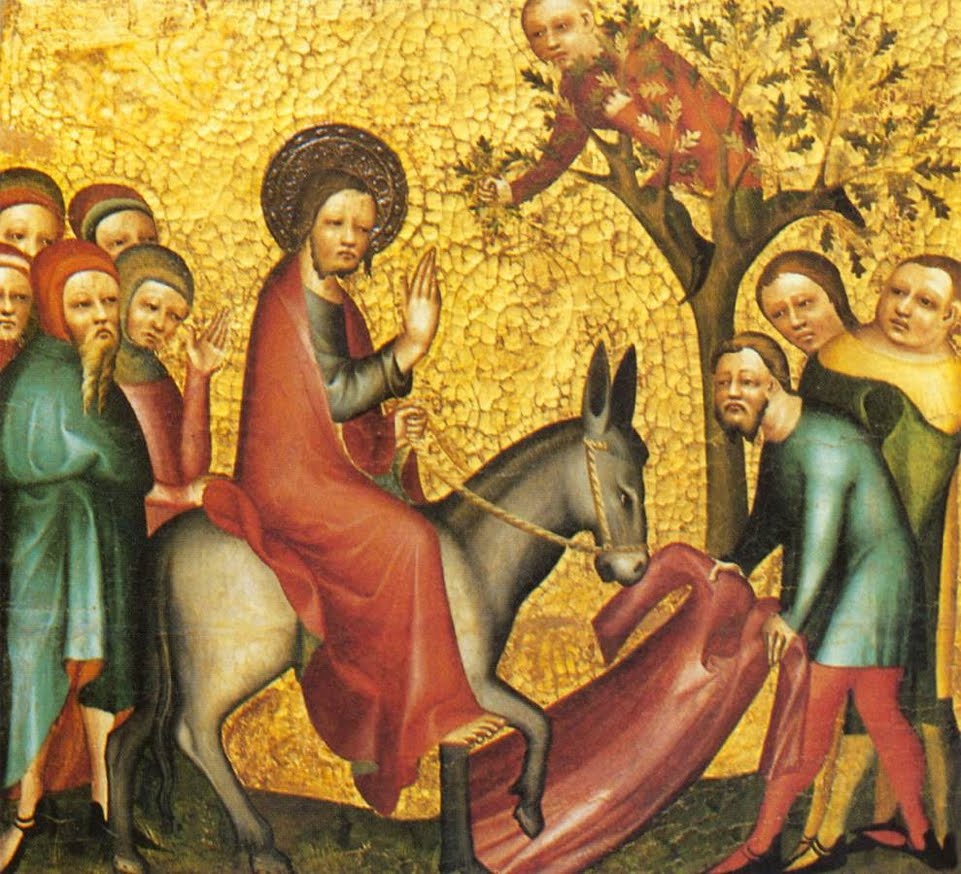 To view today’s readings, click here. (Lectionary: 37 and 38)
To view today’s readings, click here. (Lectionary: 37 and 38)
Due to the unique length of today’s readings, this homily outline will be limited to some points about the salvific meaning of the texts.
At the Procession with Palms – Lk 19:28-40
- In the Gospel read before Mass, it would be common to point out the irony of the crowd proclaiming Jesus Christ as the Messiah, since in just a few days they either will abandon him out of fear or will betray him by calling for his crucifixion.
- Nevertheless, the Anointed King that the prophets foretold was entering his city to redeem the Chosen People and all humanity.
- It was a moment of legitimate great joy.
- But no one accompanying Jesus the Master had any idea how that redemption would be accomplished, even through it was right there in the Old Testament Scriptures, for example in our first reading and responsorial psalm.
At the Mass –
Is 50:4-7
- In the first reading, Isaiah gives us a prophetic portrait of Jesus Christ the Messiah as the Suffering Servant.
- The one who belongs to God—really belongs—is always listening to God in prayer and has completely conformed himself to God’s will.
- He speaks God’s compassionate word to the people for their benefit.
- The response the prophet receives back is physical abuse. Prophets are rejected.
- No prophet ever belonged to God more than Christ, because he was God’s only beloved Son.
- No prophet ever had Christ’s life of prayer and conformity to the will of the Father.
- No one ever spoke more compassionate words to people for their own salvation.
- And no one ever faced more severe physical abuse.
- The virtue Christ exercised the most now was fortitude.
- Fortitude is courage in the face of fear and toughness in the face of suffering: “I have set my face like flint.”
Ps 22:8-9, 17-18, 19-20, 23-24
- Christ is the Son of David, the author of this psalm.
- Long before Isaiah foresaw the suffering Messiah, King David also foresaw his descendant’s ordeal.
- This is truly a startling prophecy of the Passion of Christ down to minute details.
- At the same time, for anyone who has ever been set upon by evil men, it is sickeningly familiar. It was perhaps David’s own experience when he was hunted by those loyal to Saul.
- David also foresaw his descendant’s redemption. Despite his unjust ordeal, the suffering servant “will proclaim your name to my brethren” and praise God “in the midst of the assembly.”
2 Phil 2:6-11
- This selection from St. Paul’s letter to the Philippians is one of the key passages in the New Testament. It is a meditation on what theologians call Christ’s kenosis or self-emptying [Gr. ekenosen].[1]
- God the Son came to earth not in the form of God but of man. Not in the form of a great man but of a humble man. He came in a form so humble that he permitted other men to put him to death. He did this out of obedience to his Father. This is how Christ redeemed us and became the exalted Savior of the world.
Lk 22:14—23:56
- The Redemption is not yet complete, not until Christ rises from the dead.
- He did all he did out of love for us. He has left behind the Sacrament of his Body and Blood.
- He gave the Apostles instruction on how to be servant leaders.
- Then he underwent the full human drama Luke recounts which fulfilled the predictions of the Old Testament.
- Without being facetious, we can say it is no fun to be a prophet and even less to fulfill a prophecy. The self-emptying required is hard. Noting could be harder than redeeming the world, so only God-made-Man could do it.
- Adam was the First Man and was made in the image of God. Christ who was fully God came in the image of man.
- Adam’s disobedience to God his Creator-Father brought on the universal calamity of original sin and the loss of holiness and justice for himself and all of his descendants. Christ’s obedience to God his Co-Equal Father redeems us from original and all actual sins, gives us the gift of God’s own life now, and makes us the promise of eternal life with him in heaven.
- Christ’s sacrifice is why, when we get to the part of the reading when his body hangs dead on the Cross, we kneel. It is our confession with our bodies that Jesus Christ, seemingly defeated, is Lord.
The Homiletic Directory offers the following Catechism points and themes for Palm Sunday of the Lord’s Passion:
- CCC 557-560: Christ’s entry into Jerusalem
- CCC 602-618: the Passion of Christ
- CCC 2816: Christ’s kingship gained through his death and Resurrection
- CCC 654, 1067-1068, 1085, 1362: the Paschal Mystery and the liturgy
Leave a Reply